Chapter 1. Hunting, gathering and food sharing in Africa’s rainforests The forest-based food system of the Baka indigenous people in South-eastern Cameroon
Section 1 Community and food system profile
1. GEOGRAPHIC CONTEXT
Gribe village is located in the Yokadouma district of Boumba-Ngoko department in the East region of Cameroon, 75 km southwest of the city of Yokadouma. Aside from the existing administrative boundaries, Gribe together with 20 neighbouring villages constitutes the Konabembe canton that was formed before or during the German colonial period. The village is immediately surrounded by a mix of evergreen and semi-deciduous forest with a canopy stratum culminating 40 m to 50 m above ground (Tajeukem et al., 2014). The topography is characterized by scattered gently rolling hills isolated from each other by a dense hydrographic network.
The climate of the East region is classified as tropical monsoon by the Köppen climate classification. The mean daily temperature is stable at around 24 °C throughout the year and mean annual rainfall is approximately 1 600 mm. The rainfall regime is primarily governed by the Intertropical Convergence Zone (ITCZ) and is divided into four seasons in a year (Figure 1.2).
The East region of Cameroon has the largest area (109 000 km2) of all districts in the country, but the population has always been one of the smallest. Infrastructure, comprising transportation, electricity, telecommunications and water supply, is hardly advanced. Investments were made in infrastructures that support extractive activities such as timber logging and mining.
2. LOCAL DEMOGRAPHICS AND SOCIAL ORGANIZATION
Around 20 ethnic groups are found in the East region of Cameroon, among which the majority speak Bantu languages. The Baka, who speak an Ubanguian language, are found throughout the southern part within a mosaic of 17 languages, which predominantly belong to the Niger-Congo phylum of Bantu languages.
A great majority of villages in the southern part of East region, where Gribe village is located, are constituted by (1) a dominant Bantu or Ubanguian speaking group; (2) individuals originating from a diversity of other ethnic or language groups from South-eastern Cameroon who have matrimonial ties with a native of the region; and (3) Baka. In Gribe, the Konabembe – speakers of the Mpumpong language – constitute the dominant group with a population of around 300 residing in around 55 households. Approximately 25 residents speak other Bantu languages, including Kako, Mpiemo and Koonzime (Mpumpong). Additionally, about 10 households are merchants, who have recently migrated from Yokadouma city or from outside the region or country. The Baka in Gribe have a population of approximately 400 residing in 95 households.
The Baka and Bantu speakers have mutually bonded through social relations and material and immaterial exchanges. The Baka almost all speak or understand the Mpumpong spoken by the Konabembe, and a large part of non-Baka people understand Baka, whereas each group speaks their mother tongue. In Gribe and the surrounding area, Baka collectively call different groups of Bantu speakers as bantu or kàkà, and so do Bantu speakers. We accordingly refer to the Konabembe and other Bantu speakers as “Bantu” or “neighbours” (Toda, 2014). Nevertheless, some precautions should be stated here to avoid confusion: First, the term Bantu basically refers to linguistic classifications and does not make sense without contextualization. “Pygmies groups” are commonly segregated from “Bantu” groups despite the fact that the majority of them speak a Bantu language. Second, packaging the different groups into a single “Bantu” – or “farmers”, “villagers” or “non-Pygmies” – category tends to overshadow the great diversity of livelihoods that exist amongst Bantu-speaking groups. Third, this homogenization misleadingly caricatures the binary opposition between the Baka and their neighbours, and tends to squander the diversified facets of their interrelationships (Rupp, 2003).
The Baka form residential groups composed of 5 to 20 households tied through patrilineal kinship. The members of each residential group have close mutual relationships through daily processes of sourcing, consuming and sharing food, as well as through rituals. At the same time, most groups include households from different residential origins belonging to different patrilineal entities. Notably, many cases are found where a spouse’s parents and their relatives move in and share their livelihoods. The wide range of membership in resident groups expands the range of accessible resources.
One of the major factors that has increased membership is matrilocal residence. Whereas the Baka follow virilocal residence in principle, matrilocal residence is usually followed until the husband completes payment of the bride wealth to his wife’s parents or relatives. Through this custom, the relationship between different resident groups becomes more intimate. The unit of exogamy is the clan ye, which is the largest boundary of the patrilineal descent group. Whilst the genealogical relationship between clan members is seldom remembered, spouses are strictly selected from different clans (Tsuru, 1998). There is strong tendency to search for spouses in clans that live farther away: half of the spouses of the Baka males originating in Gribe have spouses from outside the village and some men who have married local women may come from areas situated up to 200 km away. The wide distribution of patrilineal descent groups across the area has likely resulted from these processes of conjugal ties over long distances.
There are approximately 20 residential groups in Gribe, amongst which this study focused on one – the Dimgba. They established gba (semi-residential settlements) around the central area of the village that is resided by the Bantu (Figure 1.1 left). Residential group members move seasonally to the forest altogether or in smaller bundles of households, where they establish bala (forest camps). As the population size of the Dimgba group is large, they tend to form separated camps in the forest and members visit each other to share food and discuss various matters. Gender roles are relatively clear: in general, women are in charge of gathering, fishing, harvesting crops, weeding, procuring water and firewood, and cooking. Men are involved in hunting, honey gathering, clearing fields, and negotiating with the Bantu for exchange. In regards to decision-making on social issues and livelihood activities, there is no leader with specific authority. When facing problems or having to make joint decisions, concerned parties have to engage in slow and long-lasting negotiations.

The Baka believe in many kinds of me (forest spirits), which shape their religious system that is not built on a systematic precept. They segregate me from the God of Christians to which they were evangelized by foreign missionaries. Like humans, the spirits are said to live in camps in the forest, and occasionally visit Baka settlements to dance and sing with the people. On these occasions, the spirits are embodied in anthropomorphic masks. During ritual events with dancing and be (singing), men depict the visiting spirits through dances that are sustained by a chorus of women. The Baka have a rich repertoire of lìkànɔ (tales) in which they set spirits into stage. It is mainly through dreams that the spirits communicate with the Baka and impart humans with knowledge about the forest and its resources.
3. LOCAL FOOD PRODUCTION
Current livelihood and land classification
The livelihood means currently practised by the Baka in Gribe are hunting, gathering, fishing, shifting agriculture, material and labour exchanges with the Bantu, and extractivism through the harvesting for sale of Non-Timber Forest Products (NTFPs). Amongst the Baka, agriculture has increased over recent decades. The Bantu of Gribe depend mainly on agriculture, whereas they also earnestly practise hunting and gathering for subsistence, and cacao cultivation and trading NTFPs for cash income (Hirai, 2014).
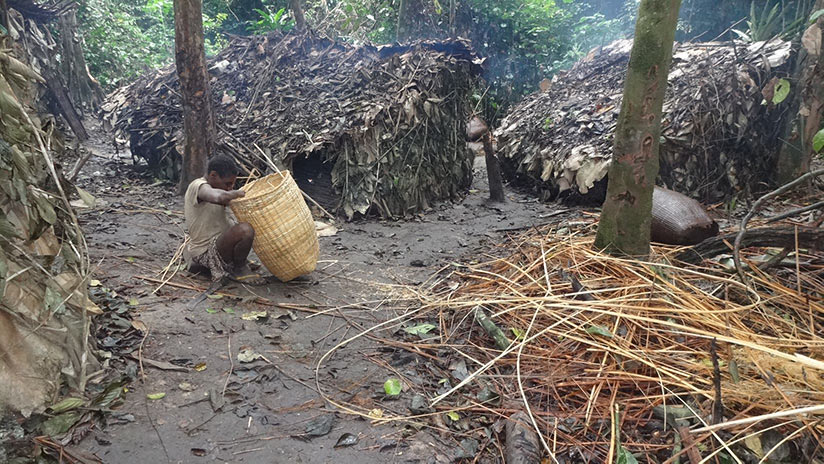
© Kyoto University/Masaki Hirai.
There are many restrictions on forest use connected with the zoning policy implemented by the Government in the 1990s and wildlife management by the protected areas. The zoning policy divided the forest that had been used so far by local people into non-permanent forest and permanent forest. The former constitutes the agroforest zone, expanding approximately 3 km on both sides of the road that passes through the village. The latter includes concession areas for timber logging (logging zone) and protected areas. Farming is only authorised in the agroforest zone. Gathering and hunting for subsistence, and fishing are possible in the agroforest zone and logging zone. In the protected areas, hunting is totally banned, whereas NTFP collection is tolerated under the condition that it is specified in the protected area management plan (Tegomo Njounan, Defo and Usongo, 2013). Further regulations are imposed for hunting in terms of target species, captive numbers and methods.
Hunting and trapping
All Baka in Gribe are involved in hunting (Yasuoka et al., 2015). Hunting activities are roughly categorised into three types: maka, mumbato and sendo. The term maka refers to large-scale expeditions to track big animals such as red river hog and elephant (Table 1.1). These expeditions are carried out in groups of about 5 to 10 men who journey around the forest for more than a week. The mumbato type of hunting involves a group of two to three men for about one week. Oftentimes, these groups are based in forest camps from where they go to trap animals and collect NTFPs. The sendo type is day hunting, which is a shorter outing from a semi-residential settlement or a forest camp. In addition, the Baka use a special trap called mɛ̀ndàmbà to capture mice and rats and slingshots to shoot small birds around the farming camp. Whilst men are the primary actors capturing animals, women are also involved in hunting by checking traps set by men and guarding men’s absent camps.
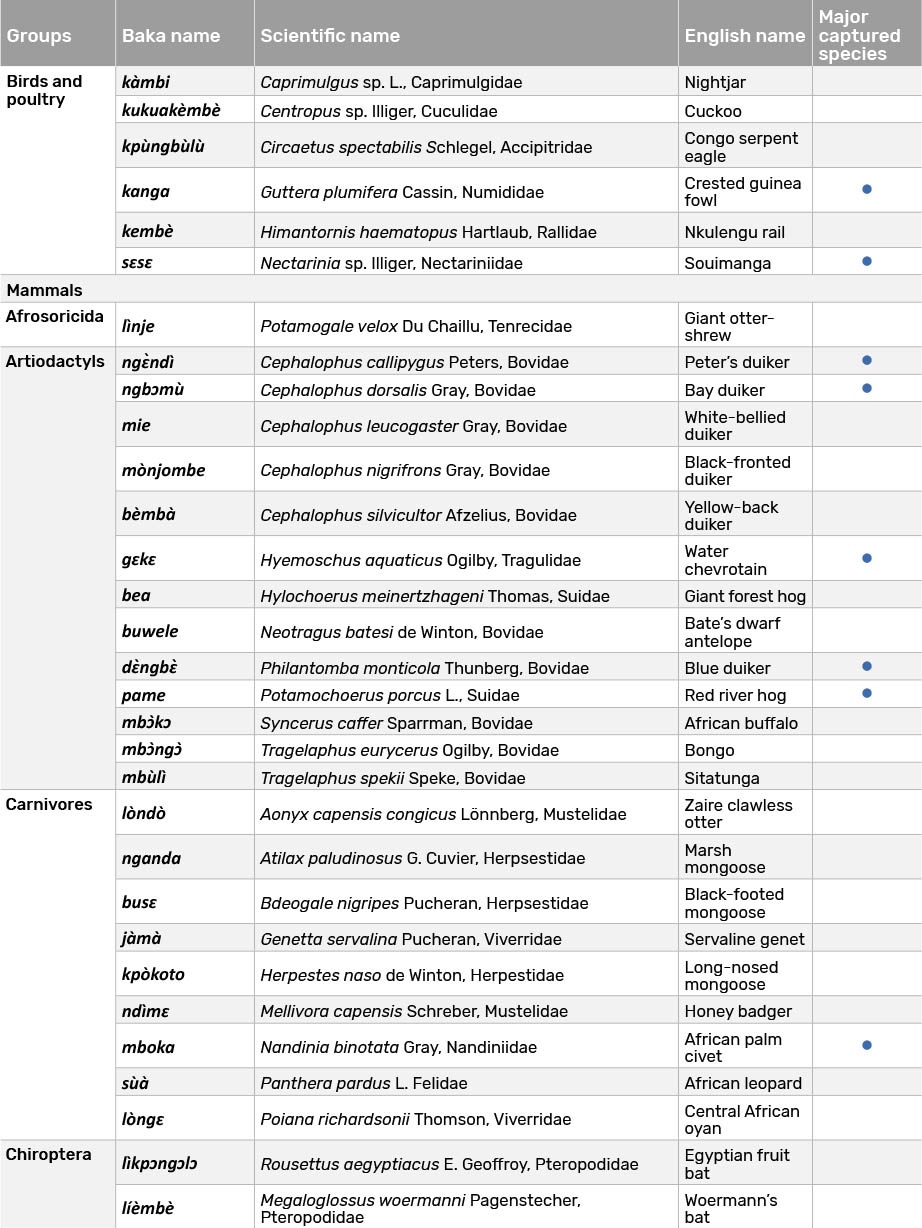

More than 50 mammal species inhabit the forest around Gribe (Table 1.1). Amongst these species, the most captured are the blue duiker, red duikers and brush-tailed porcupine. The Bantu also delegate the Baka to hunt for their consumption. Some primate species are captured when the Bantu give the Baka a shotgun. Bushmeat to exchange with Bantu or merchants is usually smoked for storage. About half of the captured animals are traded and the other half are used for self-consumption.
Wild edibles
A variety of plants, mushrooms and other wild edibles are collected by the Baka for subsistence and household economy. Table 1.2 shows the major wild edibles collected by food group, with specification of their scientific and Baka names. Eight species of wild yams (Dioscorea spp.) are notably important for subsistence. Out of the eight, two species of yam renew their tubers annually and are spread in large patches within the forest area. During the major dry season, the Baka undertake long-term harvesting expeditions for these two species to ensure their food security. By contrast, all the other yams species have perennial tubers and are more randomly distributed throughout the forest (Yasuoka, 2013). About 30 species of wild fruits are collected and consumed as oil, oily condiments, seasonings and snacks. Amongst them, kernels of kanà (Panda oleosa), seeds of màɓè (Baillonella toxisperma), and kernels of several species of Irvingiaceae trees are most frequently used. In addition, kernels of pɛ́kɛ (Irvingia gabonensis) are of particular importance for local diets and cash income. This species is available only in the minor dry season, at which time most Baka move to the forest and camp for two to three months to collect the kernels together with other forest resources. This seasonal camp is accordingly called bàlà pɛ́kɛ (Irvingia camp). Other major wild edibles collected primarily for income are fruits of Aframomum spp., ngìmbà (Afrostyrax lepidophyllus), and gɔbɔ (Ricinodendron heudelotii, njangsang), which are commonly sold as seasonings. As vegetables, the leaves of five species are collected, amongst which kɔ̀kɔ (Gnetum africanum) is the most frequently consumed and easy to gather. Mushrooms are highly valued and the Baka have a wealth of knowledge regarding their diversity, edibility and ecologies. They eat around 20 species with different seasons of occurrence. The largest forest mushrooms are the Termitomyces species that grow on mounds of Macrotermes termites. Monospecific forest patches of bèmba (Gilbertiodendron dewevrei) are known for their incredible diversity of symbiotic mushrooms.
D: major dry season; r: minor rainy season; d: minor dry season; R: major rainy season


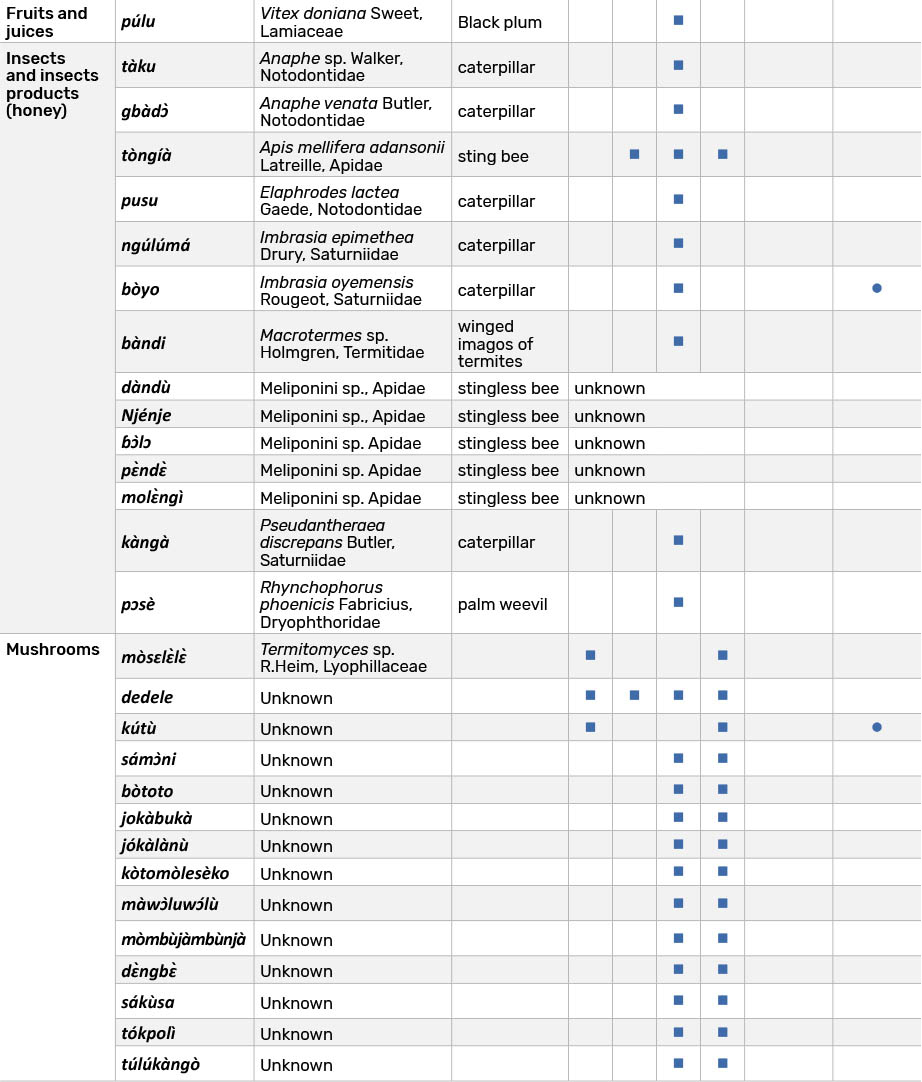
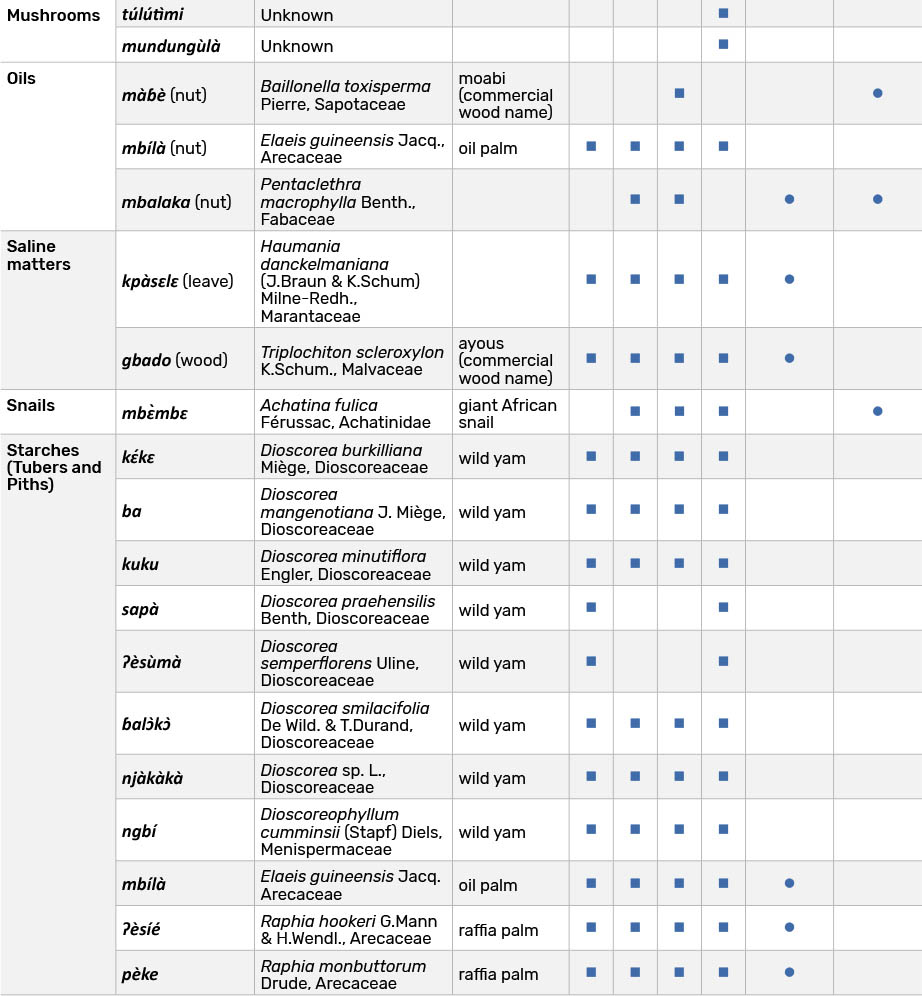
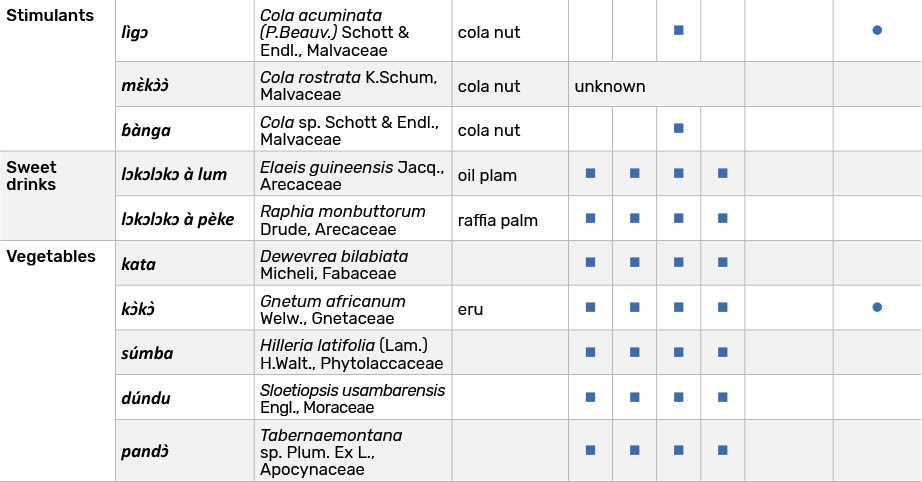
Invertebrates are also important components in Baka diets. The most popular are caterpillars, which are highly seasonal. Each species receives the name of the host tree on which they feed exclusively. Sùsu (winged termite imagos), which emerge from the ground, mounds or aerial nests around the end of the minor dry season, are highly favoured. As emergence time approaches, children and adults observe termite mounds and nests almost every day. Imagos of mbìle species emerging from the ground are captured and immediately eaten by children. For bàndi termites, adult men will dig out soldiers from the mounds and cook them as a soup ingredient. Weevil larvae are extracted from the trunk of Raffia palms (Raphia spp.) that they parasitize in swampy forests. Large Achatina snails are coveted by children and women and are easy to catch. Sting bees (Apidae) and stingless bees (a dozen species of Melliponinae) produce a diversity of honey made from different flowers throughout the year. Honey gathering is one of the most culturally important activities amongst the Baka and embeds a set of knowledge, expertise and physical skill: bee nests are often found in hollow tall trees, sometimes very high above the ground. Finding bees from the ground requires the ability to perceive the slight appearance, sound and particular atmosphere of bees. Lìɓɛnjì (insect detritus) discharged by the bee workers and accumulated at the base of the tree are indirect clues for localizing a nest. Apis nests require the gatherer to climb the tree, while cutting it down is necessary to access stingless bee nests.
Fishing
Amongst a vast range of fishing methods reported from the East region, the Baka most frequently practise ngúma (dam fishing), hand-gathering, njɛ́ɛ̀njɛ̀ (angling) and mátìndì (trapping). As the Baka of Gribe more often fish in small rivers, dam fishing is one of their favourites, during which they bank up fallen trees and soil vertically with the flow of the river. Two weirs are made at intervals of about 10 metres. After water accumulates, it is raked out with big leaves of specific Marantaceae species. As the water decreases, fish – especially carp (Cyprinidae) and catfish (Siluridae) – shrimps, crabs and tadpoles can be caught by hand. Dam fishing is regarded as women’s work, and they usually do it collectively since it requires heavy work and collaboration. This practice is limited to the major and minor dry season when the water level decreases. Hand-gathering is also a woman’s job. Women introduce a hand into a hole in the soft soil of the riverbank and catch small catfish and mbɔ̀sɛ̀ (Gnathonemus sp., Mormyridae, elephant fish) hidden there. Angling is practised by men. Finally, night trapping is a way to catch a relatively large catfish, which is done by an adult male. Fish caught are predominantly destined to domestic consumption.
Crops
All Baka in Gribe are involved in shifting cultivation with a medium-term fallowing period of more than 10 years, mixed cropping and low labour input. The clearing scale is small, about 0.1 ha per household per year. Main food crops are plantain, banana, cassava, cocoyam, sweet potato, maize, yam, taro, okra and chili pepper. Peanuts and cowpeas are grown more occasionally, when seeds are available. Cocoa, the sole cash crop, is sometimes produced in small plantations, accounting for only about 5 percent of the total cultivated area. A limited amount of plantain is occasionally sold on request. Apart from the fields, plantain, banana, cocoyam and papaya are also planted around the farming camp. Food crops are integrally destined to domestic consumption, yet some plantain bunches produced in excess might punctually be sold. The Baka also cultivate tobacco, but production rarely meets their own heavy consumption.

© Kyoto University/Masaki Hirai
Thirty-three crops were recorded in total (Table 1.3). Of these, plantain, banana, cassava, cocoyam and okra are cultivated by almost all the households. Peanut is very popular as an oily condiment yet few households can procure seeds. Only a few fruit trees are planted around the settlement, whilst others, such as papaya, occur spontaneously. Crops with multiple varieties are plantain (28), banana (5), cassava (18), cocoyam (3), peanut (4) and maize (2).
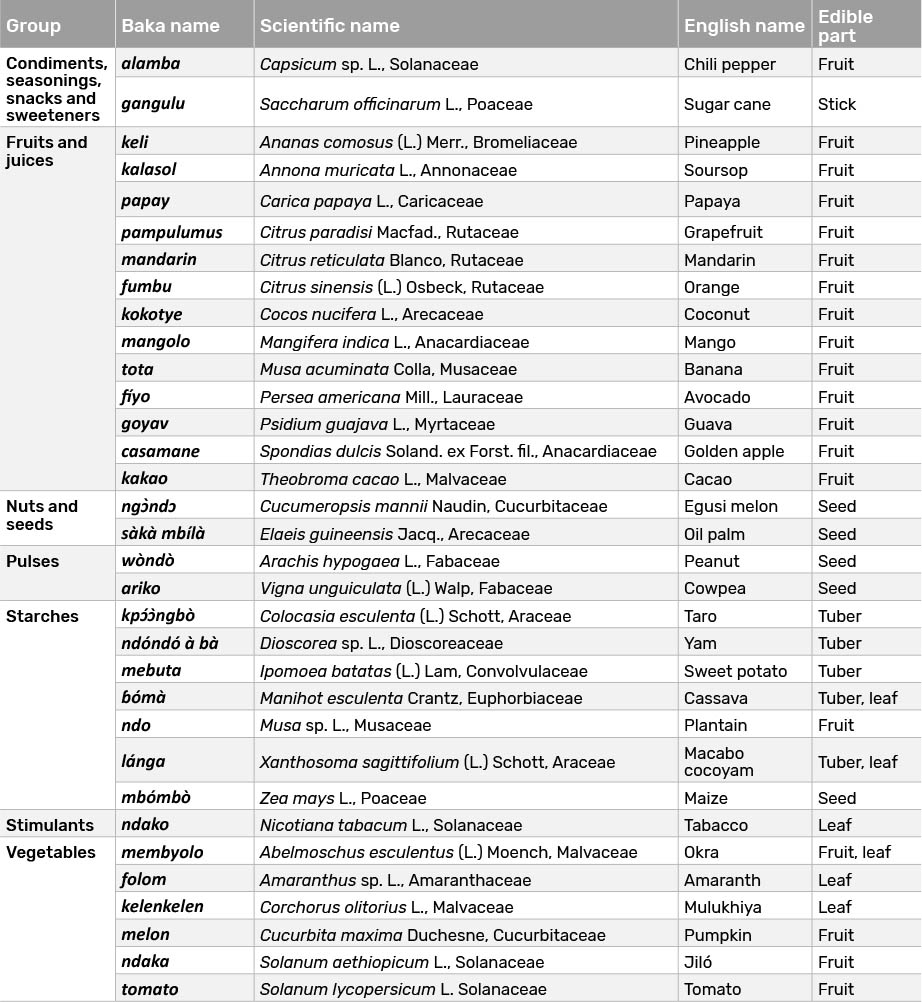
With 28 and 18 varieties, respectively, plantain and cassava count notably more varieties than other crops. Five varieties of plantain and three of cassava predominate. All of these varieties are recognized as local and ancient. All varieties are kept stable for several reasons. The first reason is Baka’s perspective that “there is no need to abandon the varieties left by parents.” They do not intend to exclude existing varieties. The second reason is related to the cropping system. For establishing new plots, suckers of plantain and sticks of cassava are procured from existing plots. As a result, a similar variety composition is inherited in the new plots. The third reason is that the Baka look for particular characteristics of each variety. The originality of each variety stimulates the Baka, which brings joy in their cultivation. The fourth reason is that consumption of plantain and cassava should be shared amongst the whole community and that cultivars should circulate beyond the boundaries of individual ownership. Similarly to wild resources, sharing is also put forward as a principle for maintaining homogenous and collectively owned diversity in cultivars. Accordingly, taking crops from a field belonging to someone else is not assimilated to stealing, and only a few persons condemn it. The Baka assume that all of them equally cultivate all the varieties, even though that is unlikely to be true.
4. OTHER LAND-BASED PRODUCTIVE ACTIVITIES
The Baka are renowned for using an extensive range of nearly 500 wild or ruderal plant species for material and spiritual purposes, and which in many ways support the food system. This section evokes only the most commonly used ones.
Some plants and soil provide basic materials for house and hut building. For the móngulu (dome-shaped hut) that the Baka build for forest camping, lìngɔ̀mbɛ (Hypselodelphys zenkeriana (K.Schum.) Milne-Redh., vines of Marantaceae) are frequently used as a frame. The roof and walls are made from leaves of three species of Marantaceae. For houses built in the farming camp, hard trees growing in the surroundings are used as pillars and leaves of Raffia palm serve for roofing, whilst lìngɔ̀mbɛ and soil provide wall material. Furniture used by the Baka includes beds, chairs, mats and shelves for drying products and placing food vessels. Beds are mainly made of the petioles of Raffia palm. Specific tree bark is used for bed sheets. Chairs are made of hard and thin shade-tolerant trees. Mats are knitted with the epidermis of the stem of mbili (Marantochloa congensis (K.Schum.) J.Léonard & Mullend., Marantaceae) and of ngòngò (Megaphrynium macrostachyum (K.Schum.) Milne-Redh., Marantaceae).
As cooking utensils, mortars and pestles are made from hard woods such as bòyo (Entandrophragma cylindricum (Sprague) Sprague, Meliaceae, sapelli). The buttress roots of ngɔlu (Terminalia superba Engl. & Diels, Combretaceae) are used to make mortars to grind nuts and other solids. To grind, the spherical and hard fruit of bùkú (Strychnos aculeata Soler., Loganiaceae) is used as a pestle. Leaves of several Marantaceae plants are frequently used as containers for carrying honey and as cooking sheets (Hattori, 2006). Rough leaves of sòmbɛm (Grewia sp. L., Malvaceae) serve for washing food vessels. Carriers are made from the hard bark of vines of kpongo (Eremospatha haullevilleana Mann & H.Wendl., Arecaceae), kàò (Laccosperma secundiflorum (P.Beauv.) Kuntze, Arecaceae) and kiyɔ (Cleistopholis patens (Benth.) Engl. & Diels, Annonaceae). In particular, several types of baskets and frame packs are woven to carry bushmeat and plants gathered by women. Vines such as kusa (Manniophyton fulvum Müll. Arg., Euphorbiaceae), kpongo (Eremospatha haullevilleana Mann & H.Wendl., Arecaceae), and púlu (Adenia tricostata Wilde., Passifloraceae) are used as rope.
Various plants are sources of cosmetics and accessories. Lɛ̀sà (Bixa orellana L., Bixaceae), ligɔ̀mbɛ (Ficus sp. L., Moraceae), mboloa (Diospyros canaliculata De Wild., Ebenaceae), nalé (unknown), ɓɔ̀njìngà (unknown) and ngɛlɛ (Pterocarpus soyauxii Hooker, Fabaceae) are applied as red or black make-up. Leaves of musébé (Pleiocarpa bicarpellata Stapf., Apocynaceae) are put on the waist as an accessory. Knowledge regarding daily use of medicinal plants is broadly shared amongst many people. However, remedies for specific diseases, especially those related to witchcraft or originating from spiritual forces, are exclusively carried out by expert healers. Their expertise of these renowned ngàngà is voiced far beyond the village surroundings: they regularly receive visits from urban patients, or perhaps travel to the country head city of Yaoundé to cure rich urban citizens or politicians.
5. EXCHANGE AND TRADE
The Baka source some of their food through exchanges with their neighbours, or in local shops and a weekly market that was created in 2017. The shops are owned by a few local Bantu households, and mostly by merchants coming from the nearest Yokadouma city or farther away. Most of the food found in local shops is processed, whilst stalls in the weekly market mainly provide food from the forest and fields. Most frequently purchased foods are rice, spaghetti, cassava flour, maize, sardines in cans, dry fish, frozen fish, salt, chemical seasonings, refined oil, peanuts, alcoholic drinks, juice, sugar and candy. Purchasing frequency is high only for seasonings and alcoholic drinks. Salt and stock cubes are a regular feature of the diet. Whiskey in a sachet, at a price of XAF 100 per sachet,1 is purchased almost every day. Nevertheless, the quantity of food bought in shops remains much lower than what they produce in their swiddens or gather in the forest. The Baka exchange their forest products and labour with the Bantu throughout the year for food, daily commodities and cash (Table 1.4) (Kitanishi, 2006). The most common example of barter between the Baka and the Bantu is kernels of pɛ́kɛ (Irvingia gabonensis) in exchange for cassava flour. Payment from the Bantu for the kernels is equivalent to XAF 5002 per 1.5 kg of dried kernel. In addition to food and labour exchanges, the Baka craft furniture and carriers and exchange them upon request with food or other items. Food sharing is common and is a natural norm amongst the Baka. If a certain household obtained food that cannot be eaten all at once, they do not store it and instead share it with others for immediate consumption.
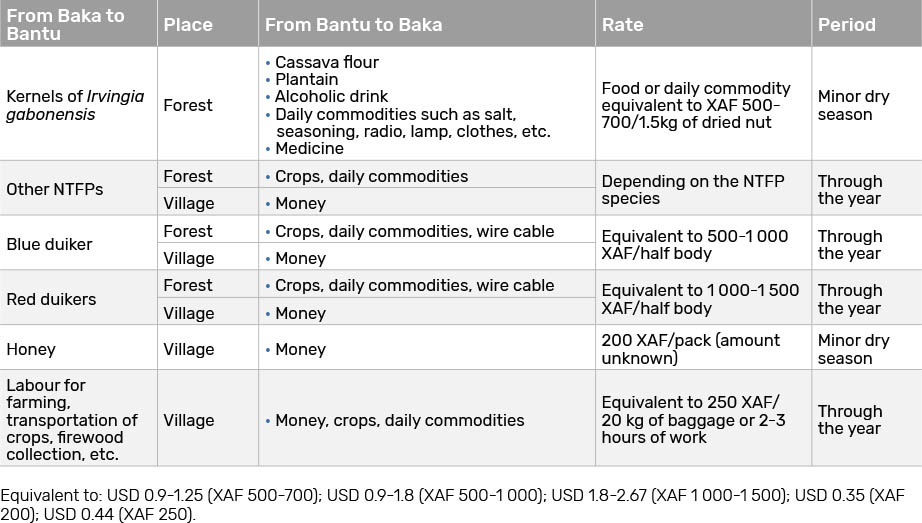
6. LOCAL CALENDAR
The Baka in Gribe classify a year into four seasons based on various changes in the environment and the occurrence of phenological events determining the availability of key resources and the related tasks and division of labour (Figure 1.2). Socio-economic circumstances occurring at the village like exchange opportunities or wage labour for the neighbours are also driving forces influencing the local calendar of activities.

The onset of the major dry season is recognized by reduction of rainfall, hardening of the soil, falling of leaves of semi-deciduous species as well as the appearance of mòsɛlɛ̀ or mòsɛlɛ̀lɛ̀ (a specific mushroom), njùmbu (bird), and butterflies. One of the most important activities is land clearance for cropping. At the beginning of the season, people start cutting trees to make plots and drying them to burn. Food resources are scarcer at this time of year, and hard ground makes it more difficult to set up traps, thus lowering bushmeat catches. However, the availability of annual wild yams such as sapà (Dioscorea praehensilis) and ʔèsùmà (Dioscorea semperflorens) is highest and dam fishing becomes easier to implement due to lower water levels in the rivers. During mòlɔ̀ngɔ̀ (past long-term expedition), which were regularly conducted until the 1980s, the Baka depended greatly on annual wild yams and fish. Nowadays, fishing camps do not last longer than one month during this period. Subsequently, incomes increase from wage labour with the Bantu who hire Baka for land clearance.
The onset of the minor rainy season is marked by a gradual increase in rainfall and leaf flushing. In agriculture, this season corresponds to the time of planting suckers of plantain, banana, cocoyam, sweet potato, domesticated yams and sticks of cassava. They also seed egusi melon, maize, okra and peanut. Taking advantage of the low water levels in rivers, the Baka establish medium-term forest camps for fishing. Trapping and gathering Aframomum spp. with high cash value are also conducted at this time. During this season, which is marked by synchronic tree blooming, honey is also more abundant.
The minor dry season is the period of mast flowering and fruiting of specific trees such as African padauk ngɛlɛ (Pterocarpus soyauxii Hooker, Fabaceae) and bɔ̀sɔ (Petersianthus macrocarpus P.Beauv. Liben, Lecythidaceae). Contrary to the major dry season, food becomes abundant. Despite the need to perform agricultural tasks, including weeding, re-dissemination, transplantation and harvesting groundnuts, most Baka prefer to move to the forest and dedicate this season to hunting, fishing and gathering of wild edibles. The kernels of pɛ́kɛ (Irvingia gabonensis) are the major targets of their gathering efforts.
A lùngu (strong wind), heavy rainfall, flooding and the occurrence of many tree seedlings, as well as rotten fruits, being washed away from the forest floor by the rain and river water are signs of the onset of the major rainy season. After October, women engage in weeding, transplanting plantain shoots and reseeding egusi melon. Time for harvesting cacao beans comes to those who have mature cacao plantations. Villagers rebuild their houses and consolidate lateritic walls that are softened by repeated rain. Baka trappers become very active now that wildlife is constantly moving in the forest understory. Aframomum spp. are still plentiful and some collectors extend their stay in the forest camp to collect Irvingia kernels, at the expense of the maintenance of their swiddens. Those who have decided to stay in the village start exploring the agroforest zone to collect Ricinodendron fruits and barter them with the Bantu.
7. COMMUNITY HISTORY
Gribe was founded in the 1890s when the six major clans of Konabembe moved to the area from different parts of the East region of Cameroon. Nearly half of the Baka of Gribe aged 50 and above state that their ancestors already lived in the area of Gribe before its foundation, whilst ancestors of the other half moved to Gribe from Messok – located about 150 km west of Gribe – and Mikel – located 35 km east – during the 1930s and 1940s. Subsequently, many Baka were living along the Kwokwo River (Figure 1.1 right).
In 1954, an elementary school and church were constructed in Gribe, probably under the incentive of the French colonial Government (Kitanishi, 2003). Following the independency of Cameroon in 1960, timber logging suddenly expanded. In 1978, the national road connected Yaoundé and Yokadouma, attracting a flow of wage labourers from the western part of the Boumba-Ngoko department, including some villages around Gribe, to the eastern part of the department for logging. In the early 1980s, merchants from Yokadouma city started to visit Gribe by foot in search of cacao beans, ivory and seeds of nèà (Strophanthus gratus (Wall. & Hook.) Baill., Apocynaceae), which produce strophantin, an alkaloid with cardiotonic properties that has been coveted by chemistry. In times of molecular synthesis by the chemical industry, the market for Strophantus seeds has now vanished, but the Baka persist in harvesting them as a key ingredient of poison for mbànɔ (crossbow arrows). Regular merchants started retailing daily commodities, including salt, sugar and soap. Around 1985, the Baka of Dimgba and their ancestors engaged in small-scale farming. At the same time, the practice of long-term foraging began to drop.
From 1997 to 2001, three timber logging companies started full-scale activities around Gribe. The road from Yokadouma city to Gribe was opened in 1997 to support these activities. In 1998, a ferry was installed to cross the Boumba River half-way between Yokadouma and Gribe. In 2001, the road was further extended beyond Gribe and ultimately reconnected with the road of the neighbouring Haut-Nyong department. These communication improvements abruptly eased the access to the district, increasing the flow of all sorts of outsiders, such as logging company workers, itinerant merchants and speculators. At the same time, the Baka started establishing semi-residential settlements in the near vicinity of Gribe.
In the late 1990s, the Government put the zoning policy into effect for all lands in the East region. In 2005, Boumba-Bek National Park was founded 16 km southwest from Gribe. A hunting zone, for licenced hunting, and a community-based management hunting zone, for licenced hunting managed by the semi-public organizations called “Comités de Valorisation des Ressources Fauniques” (COVAREF), have additionally defined the range between the agroforest zone and logging zone.
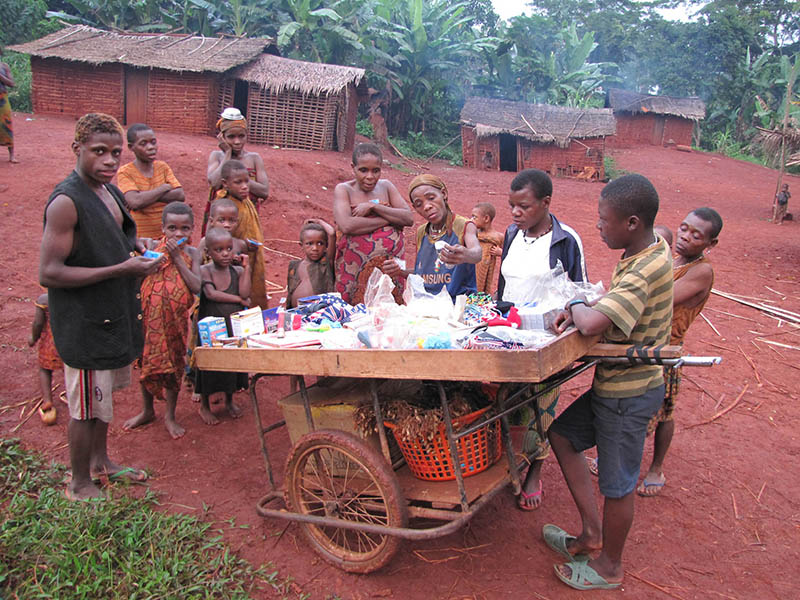
© Kyoto University/Masaki Hirai
“Individual independence in food sourcing is important to eat well and share food with everyone.”
Saying of the Baka from Dimgba.
